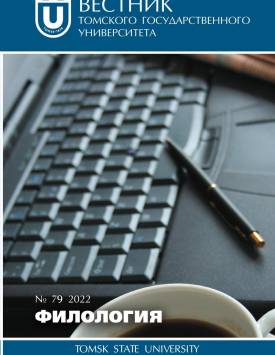The “self-building plot” about the poet-prophet in Russian lyric poetry of the 19th and 20th centuries
Based on the ideas of S.G. Bocharov about the presence of “self-adapting mainstream super-plots”, formed as a result of contacts between works and developing in the field of entire literature in the space of Russian literature, the article proves the possibility of considering a number of Russian lyric poetry works, from Gavrila Derzhavin’s “God” (1784) to Timur Kibirov’s poem “A Pale Youth Coming Out to Print” (1998), as compositional and semantic parts of one of such superplots. The author studied texts dialogically connected through titles, common motifs and images (and above all the image of a poet, who somehow self-identifies in relation to the mission “poet-Prophet”), and focused on reflections on the fate and purpose of the poet and poetry. The intertextual analysis of such texts shows that, for more than 200 years, a special plot “self-aligned” in Russian lyric poetry - a basically dramatic path of a poet losing his mission, which is a consistent separation from the Creator, people and art as the meanings and goals of his high service. In the course of the analysis, the author has established that it is possible to interpret “what is happening” in Derzhavin’s ode, Pushkin’s, Lermontov’s, Nekrasov’s “The Prophet”, in Bryusov’s poem “A Pale Youth With a Burning Gaze”, then in “The Prophet” by V. Kazantsev, and, finally, in Kibirov’s “A Pale Youth Coming Out to Print” as plot events, compositionally correlated with the exposition, setting, and course of action, the climax and denouement of a single super-plot, unfolding chronologically logically from the point of view of both artistic reality and the historical and cultural context. The author of the article reveals a feature of this super-plot: on the one hand, it is the ideological-figurative “attachment” of the first four in the above-mentioned series of poems to the Biblical texts, and, on the other hand, the explicit going beyond the Sacred history in the 20th century, as a result of which the universal biblical plot is somewhat “finished”. Using the method of structural analysis of poems, the author idenyifies general constructs which connect texts both with each other and with a universal plot: two planes of space - earthly and another - with the possibility of their meeting at the lyrical subject’s or the described actor’s location and interdimensional movements; established or recalled contact with a transcendental entity; the inevitability of sacrifice; self-determination in relation to the mission of the Prophet. The general conclusion is drawn about the dramatic nature of the unfolding path of the poet-Prophet, which also manifests itself at the level of pathos: a change in intonation from odic at the beginning to ironic in the final text, which signifies the collapse of the very idea of poetry serving to anything and the impossibility for poetry to acquire meaning beyond itself. The author declares no conflicts of interests.
Keywords
“self-building plot”, Prophet, mission of poet, way of creative subject’s self-determinationAuthors
| Name | Organization | |
| Oblasova Tatyana V. | Tyumen State University | tatianaoblasowa@yandex.ru |
References

The “self-building plot” about the poet-prophet in Russian lyric poetry of the 19th and 20th centuries | Vestnik Tomskogo gosudarstvennogo universiteta. Filologiya – Tomsk State University Journal of Philology. 2022. № 79. DOI: 10.17223/19986645/79/13
